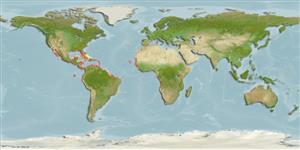Common names from other countries
Classification / Names / Names
आम नाम | उपशब्द | Catalog of Fishes (gen., sp.) | ITIS | CoL | WoRMS
Environment: milieu / climate zone / depth range / distribution range
पारिस्थितिकी
; गहराई सीमा 0 - 5 m (Ref. 106471). Tropical; 40°N - 35°S, 126°W - 28°E
Indo-Pacific and Atlantic: from Baja California (Mexico) to Chile, including Clipperton Island, Galapagos Islands and other Pacific oceanic islands; from south Florida to central America, West Indies, to Colombia, Venezuela and Brazil, to western Africa and Portugal, including Azores, Cape Verde, Sao Tome and Principe, Ascension and Saint Helena. Subtropical and tropical.
Length at first maturity / आकार / वज़न / Age
Maturity: Lm ?, range 3 - 3.38 cm Max length : 7.7 cm CL पुल्लिंग / अलिंग; (Ref. 435)
Maximum carapace width: 8.7 cm. Inhabits rocks near water line and is very active on land, taking refuge in the sea when threatened (Ref. 435). Supralittoral to intertidal (Ref. 104055). Abundant in splash zones (Ref. 105697). On rubbles (Ref. 106471). Feeds on cirripedes, mytilids, and porcelain crabs; occasionally acts as a scavenger. Also preys upon sea turtles and on the lookout for marine birds nest (Ref. 106452). Herbivorous (Ref. 106455).
Life cycle and mating behavior
परिपक्व अवधि | पुनरुत्पत्ति | मछलीऔ का अंडे देना | अंडे | Fecundity | लार्वा
Members of the order Decapoda are mostly gonochoric. Mating behavior: Precopulatory courtship ritual is common (through olfactory and tactile cues); usually indirect sperm transfer.
Fischer, W., G. Bianchi and W.B. Scott (eds.). 1981. (Ref. 435)
IUCN Red List Status (Ref. 130435)
CITES status (Ref. 108899)
Not Evaluated
Not Evaluated
Human uses
मात्स्यिकी: निर्वाह मात्स्यिकी
| FishSource | Sea Around Us
साधन
इंटरनेट स्रोत
Estimates based on models
Preferred temperature
(Ref.
115969): 22.2 - 28.3, mean 27.1 (based on 1189 cells).
Vulnerability
Low vulnerability (10 of 100).
Price category
Unknown.
